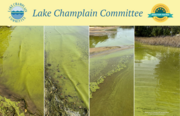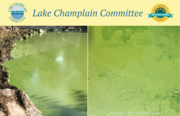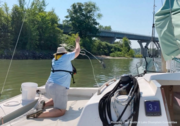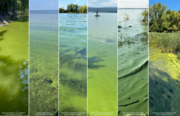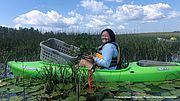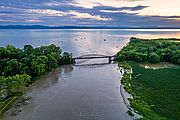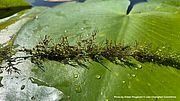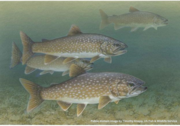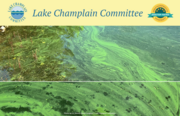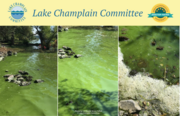Fall is a time of year when we have far fewer monitors reporting but blooms are still prevalent. Forty-three percent of the Lake Champlain reports and 8 percent of the VT inland lake reports we received for Week 14 were of blooms. Please use the resources and photos in this email to help you learn how to recognize cyanobacteria and stay informed about water quality. Read...
News from Selected Month
Week 13 was a challenging one as blooms took off in new areas and persisted in others and the online reporting system overseen by the VT Dept. of Health (VDH) was not accessible for several days while IT staff worked to resolve issues. This meant monitors had to try to submit reports multiple times and LCC staff had a backlog of reports to sort through and vet once the tracker came back online. Over one third of the 126 reports we ultimately received during the week were of blooms which further reinforces the need to check water conditions carefully even during the fall.
Lake Champlain currently has 51 known aquatic non-native and invasive species of plants, fish, mussels, and other freshwater dwellers. Invasive species are both non-native, or introduced to an area outside the range in which they evolved, and nuisance, or disruptors of the ecosystem into which they were introduced. Zebra mussels, Eurasian watermilfoil, and water chestnut are all invasive species found in Lake Champlain.
Humans have the greatest influence on the spread of invasives—hitchhikers need a ride to get to where they’re going, and humans are highly-mobile hosts that give rides knowingly through deliberately releasing fish into waterways or flushing exotic aquarium plants down the toilet, and unknowingly on watercraft. Fortunately, humans can also play a key role in early detection and spread prevention. That is why the Lake Champlain Committee (LCC) started a new community science project: the Champlain Aquatic invasive Monitoring Program (CHAMP!) with funding from the Lake Champlain Basin Program. Read...
Hints of color are starting to show in the Adirondacks and the Green Mountains as we move into fall. Another dramatic show of color that elicits less awe and more concern has been in the lake between these mountains since early summer—the blues and greens of cyanobacteria blooms.
“Witnessing a cyanobacteria bloom can take an emotional toll,” notes LCC Executive Director Lori Fisher. “Blooms threaten water quality, public health, recreation, the economy, and quality of life. Monitoring is a way for people to get actively involved in lake protection by gathering and sharing data. And that monitoring is not the end result – it’s foundational to LCC’s nutrient reduction advocacy.” Read...
Gardens were not the only places being weeded in August—LCC hosted a water chestnut removal event with the Vermont Department of Environmental Conservation at the Sandbar Wildlife Management Area in Colchester, VT. Volunteers spent the morning paddling the shallow waters north of the mouth of the Lamoille River and pulling up the invasive plant to help prevent it from colonizing the area. Read...
The Summer 2023 floods brought devastation to so many throughout the Lake Champlain Basin—they inundated homes and businesses, destroyed crops and livelihoods, and washed away roads. On paper, it will be a costly recovery, but the true cost of the destruction cannot be measured in money alone. Rivers throughout the basin rushed to levels not seen in nearly 100 years, with staggeringly high flow ultimately pouring into Lake Champlain. What did the rivers carry, what does this mean for the lake, and how can we be more resilient in the future? Read...
The Lake Champlain Committee is a partner in a new program called Stream Wise. Organized by the Lake Champlain Basin Program, Stream Wise is a way for people who live near streams and rivers to be recognized and rewarded for maintaining a healthy stream buffer. The program consists of an assessment where a trained Stream Wise assessor visits your property and helps determine if it meets the criteria to be considered “Stream Wise” and issues awards and recommendations accordingly. It helps landowners learn about what makes a stream buffer effective and how to improve the land around the waterway that runs through or along their property. Read...
In the shallow shores of Lake Champlain, a predator who engulfs its prey in milliseconds floats just below the surface, waiting for the next unlucky victim. It is neither freshwater shark nor sinister cryptid cousin to Champ, but actually a seemingly innocuous, yet carnivorous native plant: the bladderwort. Read...
For those who tend lawns, there are still a few more weeks until mowing season shifts to raking season. As such, there is time to make simple yet impactful changes to your lawn maintenance that will benefit soil health, water quality, and save you time.
If you have a grass lawn and want to keep it that way, there are management practices that you can adopt to reduce runoff and promote water quality. Consider Raising the Blade to at least three inches. This allows roots to grow deeper, as grass can divert energy to extending roots rather than re-growing the cut blades. Deeper roots aerate the soil and improves capacity for water retention. Raise the blade to a point where you’re removing less than 1/3 of the grass blade when mowing. This reduces stress to your lawn, which helps it stay green and lowers water demand. Leave the grass clippings where they fall after mowing—they will help fertilize the grass naturally as they decompose, foster a healthier lawn, and save you time! Read...
The story of lake trout in Lake Champlain is one of mystery and hope. In spring 2023, the Lake Champlain Fish and Wildlife Management Cooperative – a working group of fisheries professionals from the New York State Department of Environmental Conservation, the Vermont Fish and Wildlife Department, and U.S. Fish and Wildlife Service – announced plans to halve the annual stocking of lake trout in Lake Champlain this year. They cut back because of increases in lake trout wild recruitment, or survival past the first winter of life. This follows a trend of jumps in lake trout populations and subsequent reductions in stocking—there was a 30% reduction in trout stocking in 2022. While thousands of animal populations across taxa around the world plummet, the native lake trout of Lake Champlain are making a comeback. Why? Read...
We had fewer reports during week 12 in part due to a lower incidence of blooms but also because municipal and state parks are closing and seasonal staff and volunteers are leaving the region so there are fewer monitors reporting as summer ends. However, fall blooms are not uncommon so the monitoring program will continue through October with reduced site coverage. Lower temperatures will cool the water surface and generally reduce the incidence of blooms in deeper waters like Lake Champlain’s Main Lake, but shallow water areas like Missisquoi and St. Albans Bay and Lake Carmi will be less affected and blooms may continue. Read...
It was another challenging week for water quality with nearly half of the 188 reports received from Lake Champlain sites chronicling blooms during week 11. Hot temperatures over the Labor Day weekend spurred cyanobacteria growth and blooms were reported in every Lake Champlain lake segment except for the South Lake. Read...
During week 10 of cyanobacteria monitoring over a third of the 148 Lake Champlain reports received were of blooms. Blooms were dominant again in St. Albans Bay and Missisquoi Bay but also colored waters and shoreline areas in parts of the Inland Sea, Main Lake North, and Malletts Bay. Main Lake Central, Main Lake South, and the South Lake were bloom-free. Read...

